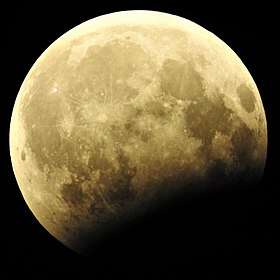February 2027 lunar eclipse
A penumbral lunar eclipse will take place on February 20-21, 2027.
| Penumbral Lunar Eclipse February 20, 2027 | |
|---|---|
 The moon will perceptibly dim as it passes through the Earth's southern penumbral shadow | |
| Series (and member) | 143 (19 of 73) |
| Duration (hr:mn:sc) | |
| Penumbral | 4:00:59 |
| Contacts | |
| P1 | 21:12:20 UTC |
| Greatest | 23:12:51 |
| P4 | 1:13:19 |
Visibility
It will be completely visible over Africa, Europe and western Asia, will be seen rising over most of the Americas, and setting over eastern Asia and western Australia.
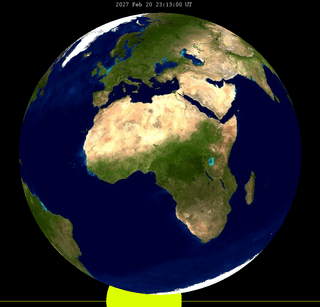
Related eclipses
Lunar year series
| Lunar eclipse series sets from 2024–2027 | ||||||
|---|---|---|---|---|---|---|
| Descending node | Ascending node | |||||
| Saros | Date | Type Viewing |
Saros | Date Viewing |
Type Chart | |
| 113 | 2024 Mar 25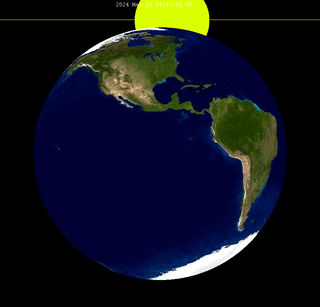 |
Penumbral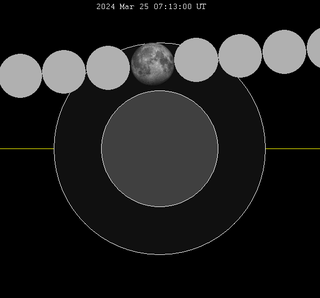 |
118 | 2024 Sep 18 |
Partial | |
| 123 | 2025 Mar 14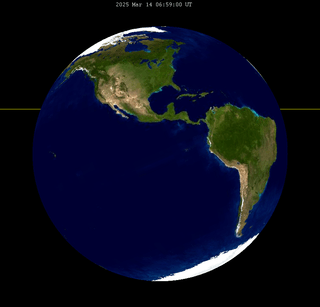 |
Total |
128 | 2025 Sep 07 |
Total | |
| 133 | 2026 Mar 03 |
Total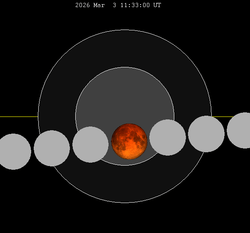 |
138 | 2026 Aug 28 |
Partial | |
| 143 | 2027 Feb 20 |
Penumbral |
148 | 2027 Aug 17 |
Penumbral | |
| Last set | 2023 May 05 | Last set | 2023 Oct 28 | |||
| Next set | 2028 Jan 12 | Next set | 2027 Jul 18 | |||
Saros series
It is part of Saros cycle 143.
Metonic cycle (19 years)
This is the last of five Metonic lunar eclipses.
The Metonic cycle repeats nearly exactly every 19 years and represents a Saros cycle plus one lunar year. Because it occurs on the same calendar date, the earth's shadow will in nearly the same location relative to the background stars.
| Descending node | Ascending node | |||||
|---|---|---|---|---|---|---|
| Saros | Date | Type | Saros | Date | Type | |
| 103 | 1951 Feb 21.88 | Penumbral | 108 | 1951 Aug 17.13 | Penumbral | |
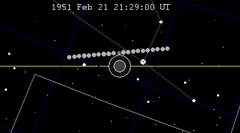 |
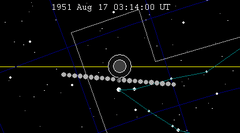 | |||||
| 113 | 1970 Feb 21.35 | Partial | 118 | 1970 Aug 17.14 | Partial | |
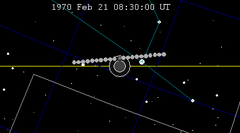 |
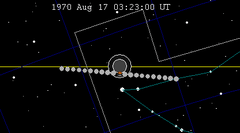 | |||||
| 123 | 1989 Feb 20.64 | Total | 128 | 1989 Aug 17.13 | Total | |
 |
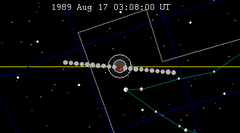 | |||||
| 133 | 2008 Feb 21.14 | Total | 138 | 2008 Aug 16.88 | Partial | |
 |
 | |||||
| 143 | 2027 Feb 20.96 | Penumbral | 148 | 2027 Aug 17.30 | Penumbral | |
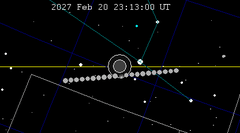 |
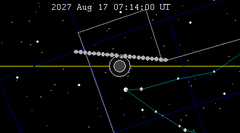 | |||||
Half-Saros cycle
A lunar eclipse will be preceded and followed by solar eclipses by 9 years and 5.5 days (a half saros).[1] This lunar eclipse is related to two partial solar eclipses of Solar Saros 150.
| February 15, 2018 | February 27, 2036 |
|---|---|
 |
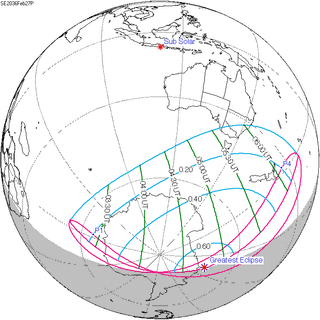 |
gollark: Pass them around as arguments and such.
gollark: I totally would.
gollark: join flattens a nested monad thing into an unnested one.
gollark: bind/>>= is essentially just map and join.
gollark: Unironically, they're the principled™ functional™ way the Haskell people came up with to sequence side effects and state on top of lazy evaluation.
See also
- List of lunar eclipses and List of 21st-century lunar eclipses
References
- Mathematical Astronomy Morsels, Jean Meeus, p.110, Chapter 18, The half-saros
This article is issued from Wikipedia. The text is licensed under Creative Commons - Attribution - Sharealike. Additional terms may apply for the media files.
